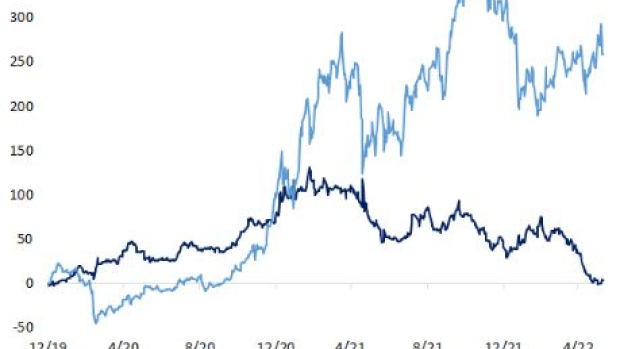Jun 12, 2022
Why Bitcoin Sees Most Of Its Gains While US Traders are Asleep
, Bloomberg News

(Bloomberg) -- When Wall Street goes to sleep, Bitcoin is usually just getting going. It often parties all night long, and in the process, notches more robust gains than while US markets are open.
A hypothetical strategy that buys the coin at the equity-market close -- at 4 p.m. in New York -- and sells it at the next day’s open -- at 9:30 a.m. -- yields gains of roughly 260% going back to the start of 2020, according to Bespoke Investment Group. Conversely, buying it at the US market open and selling it at the close spits out an advance of 3.6%. The coin even tends to trend higher during weekends, the firm found, when stock investors are resting or barbecuing or doing whatever weekend activities they’re fond of.
Yet no one seems to be able to agree on why this might be happening.
Theories abound, with some positing that investors have no choice -- thanks to the market’s 24/7 nature -- but to turn to crypto while stocks are closed for trading. Others suggest that crypto traders are forced to process loads of information overnight, which gives way to large price swings.
Here are a few views on why the phenomenon might be happening:
The Nature of a 24/7 Market
The fact that cryptocurrencies trade around the clock every day of the week makes Bitcoin, by default, the most watched and traded asset when traditional markets are closed, and that’s a top reason for the overnight phenomenon, says Bloomberg Intelligence’s Mike McGlone. “It’s the most fluid global 24/7 trading vehicle in history, which means it’s a leading indicator on the downside too,” he said.
Geographical Differences
In the US and certain other geographies, riskier assets have sold off this year as the Federal Reserve and other central banks institute policies to combat high inflation. But that might not be the case everywhere, and risk-on attitudes may still be at play across Asia, for instance, says Noelle Acheson, head of market insights at Genesis Global Trading.
Back in 2015 and 2016, China had been a focal point for Bitcoin trading -- that’s where mining took off and most of the trading volume originated, she said. “There are different cultural attitudes toward riskier investments.”
In addition, some investors might be more drawn toward using leverage, and international venues are sometimes more permissive in that way. Original crypto exchanges used to offer 125x leverage, said Acheson, though, in the US, regulators have looked to curtail such access. “So they are much more used to high leverage, it’s much more what they expect,” she said.
Longer Span of Time
Bitcoin’s correlation to equities could be another factor at work, which is something analysts have been pointing to all year as both cryptos and equities have sold off. Both stocks and digital assets are considered riskier plays, so the two have moved hand-in-hand, says Jake Gordon at Bespoke Investment Group.
Still, the correlation to stocks may not explain why the trend of after-hours outperformance also existed when the market was rallying over the past two years, he said. So another explanation is that the post-close strategy covers a longer span of time, “meaning there is the potential for more news/catalysts to account for.”
Watching the Charts
From 2021 onwards, due to China’s crackdown on crypto, trading volumes and flows have tended to peak around 9:30 a.m. Eastern Time, according to Chiente Hsu, co-founder and CEO at ALEX, a DeFi platform. “So trading volume is highly correlated to the US stock market trading hours,” she said in an interview. Hsu, who used to work at Morgan Stanley, cited a research paper showing that the overnight trend of buying at the close and selling at the open was also prevalent in the stock market before the pandemic.
But why might that be the case? Hsu says information flows build up overnight, though that’s mostly prevalent during uptrend markets. What about bear markets? “In a downtrend market, it shouldn’t work, particularly in very volatile, range-bound markets,” she said, adding that she’d like to see more research on these types of topics, as well as how transaction costs play a part.
Correlations
Vetle Lunde, analyst at Arcane Research, says he expected US trading hours to be the most significant contributor to the Bitcoin selloff in recent months, but hadn’t expected to see that being the only contributor. “Then again, it confirms what we’ve seen elsewhere in the market,” Lunde said, citing the coin’s strong correlation to stocks this year.
“We saw in mid-2020 to early 2021 that US trading hours were the key trading hours for the initial liftoff during the early bull market. That period was characterized as a period of huge institutional flows into Bitcoin,” Lunde wrote in a message.
“Now, most of the institutional market has been focused on de-risking, with the macro backdrop related to inflation and interest-rate hikes being the key component behind the de-risking. This has most definitely had a severe impact on Bitcoin and is likely the root cause behind the very potent continuous selling pressure during US trading hours.”
©2022 Bloomberg L.P.





